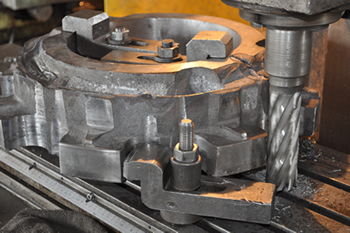Machining Processes
- Milling
 The technological machining operation by cutting achieved by the rotation of the tool and advances caused by the movement of the component.
The technological machining operation by cutting achieved by the rotation of the tool and advances caused by the movement of the component.
The dimensional areas the company can deal with are between 10÷1200mm, for flat surfaces and curves, and in particular we are preparing to address involute or helical milling, using the 5th axis of the reference system of specialised milling machines.
For the technological organisation under just conditions, the company aimed at the following major elements:
1. to provide the maintenance of the machines and tools for regular inspection and dimensional calibration.
2. to provide advanced tools that can be used in high cutting conditions with efforts of up to 160-190Nm.
3. technological preparation specific to each component, particularly for curved and involute surfaces.
4. training and educational courses for operators.
5. approval of those operations requiring high costs.
6. ensuring a policy for the implementation of the quality assurance system.
- Turning
 The technological operation by turning for revolution profile components.
The technological operation by turning for revolution profile components.
It is a complex operation requiring a thorough preparation in the form of the cutting tools and parameters.
By turning, the company can process components with sizes ranging between Ø1700x4000mm.
To achieve the required and desired productivity, the benchmarks have been divided by groups and categories (types) to define the optimum cutting conditions that contribute to the accuracy of execution and required geometric and dimensional precision.
It has efficiently contributed to the technological preparation of the execution by types and specific operations, which provided us with the opportunity to homologate the execution of these types of benchmarks, decisively contributing to defining the quality assurance system with its basic feature, which is traceability.
For this, we had the specialised documentation, our own experience as the support for using the types of existing machine-tools, as well as the use of CNC machine to achieve the necessary productivity.
- Grinding
 The technological operation of mechanical cutting with grinding wheels.
The technological operation of mechanical cutting with grinding wheels.
The company is able to make components on flat grinding machines with sizes of 1000x350 and inside and outside round grinding machines of up to 400 mm.
Knowing that this final operation performed on the components requires major responsibility on the overall execution costs, all elements competing in making these components have been analysed in detail and a number of measures was taken with the intention to eliminate the additional costs due to non-quality, as follows:
1. daily verification and calibration of the measuring instruments.
2. use of grounding wheels appropriate for the their materials and hardness.
3. use of tested cooling emulsions from certified suppliers.
4. providing the maintenance and calibration of the machine-tools.
5. use of rigid machines secured in foundations, removal of vibrations.
6. use of cutting regimes approved for the removal of surface micro-cracks, due to overheating
- Cutting
 Technological operation for a large volume of components that requires sustained productivity led to purchasing 3 new Bomar belt machines, with the possibility to cut up to 250 mm respectively 400 mm.
Technological operation for a large volume of components that requires sustained productivity led to purchasing 3 new Bomar belt machines, with the possibility to cut up to 250 mm respectively 400 mm.
In order to achieve the necessary productivity and low operating costs, we use belts of different hardness and profiles of the cutting teeth depending on the materials that go into production.
- Hobbing
 The company's capacity regarding the execution of gears extended to their milling with worm milling machines and mortising with profiled knives on Silex type machines.
The company's capacity regarding the execution of gears extended to their milling with worm milling machines and mortising with profiled knives on Silex type machines.
The execution areas are:
1. straight and angled teeth for gears with diameters of 1600 mm and module of maximum 16-20mm
2. bevel gears obtained on specialised machines by mortising cover the areas with a max. diameter of 300mm and module of 12-15mm
3. curved tooth gears are made on specialised machines with profiled knives, the size range is of max. 350mm in diameter and modules of 8-10mm
To deal with the manufacture and wide dimensional variety, we created a solid basis of design, constructions and technologies that provide more than 80% of the orders received.
We developed an efficient collaboration for the procurement of worm-type tools – profiles knives modules and fasteners.
Training courses have been initiated for the manufacturing personnel in order to know and implement the company’s policy and of an appropriate level of knowledge to use the machines and understand the manufacturing technologies.
As shown, other elements should also be dealt with, for which it is necessary to provide the resources for the implementation.










